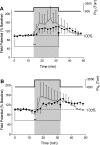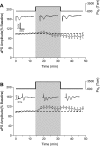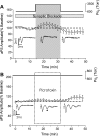Hyperoxic stimulation of synchronous orthodromic activity and induction of neural plasticity does not require changes in excitatory synaptic transmission
- PMID: 20558752
- PMCID: PMC2944636
- DOI: 10.1152/japplphysiol.91430.2008
Hyperoxic stimulation of synchronous orthodromic activity and induction of neural plasticity does not require changes in excitatory synaptic transmission
Abstract
The first study, described in the companion article, reports that acute exposure of rat hippocampal slices to either hyperbaric oxygen (HBO: 2.84 and 4.54 atmospheres absolute, ATA) or normobaric reoxygenation (NBOreox; i.e., normobaric hyperoxia: 0.6 or 0.0→0.95 ATA) stimulates synchronous orthodromic activity in CA1 neurons, which includes activation of O2-induced potentiation (OxIP) and, in some cases, hyperexcitability (secondary population spikes, sPS). In this second study we tested the hypothesis that HBO and NBOreox increase orthodromic activity of CA1 neurons (oPS, orthodromic population spike) and OxIP via a combination of both increased excitatory synaptic transmission (field excitatory postsynaptic potential, fEPSP) and intrinsic excitability (antidromic population spike, aPS). HBO and NBOreox increased the oPS but rarely increased or potentiated the fEPSP. HBO exposure produced epileptiform antidromic activity, which was abolished during inhibition of fast GABAergic and glutamatergic synaptic transmission. Decreasing O2 from 0.95 ATA (control) to 0.6 ATA (intermediate O2) or 0.0 ATA (hypoxia) reversibly abolished the fEPSP, and reoxygenation rarely induced potentiation of the fEPSP or aPS. Intracellular recordings and antidromic field potential recordings, however, revealed that synaptic transmission and neuronal excitability were preserved, albeit at lower levels, in 0.60 ATA O2. Together, these data indicate that 1) the changes in excitatory postsynaptic activity are not required for stimulation of the oPS during and HBO/NBOreox or for activation of OxIP, suggesting the latter is a form of intrinsic plasticity; 2) HBO disinhibits spontaneous synaptic transmission to induce epileptiform activity; and 3) although synchronous synaptic activation of the CA1 neuronal population requires hyperoxia (i.e., 0.95 ATA O2), synaptic activation of individual CA1 neurons does not.
Figures










Similar articles
-
Hyperbaric hyperoxia and normobaric reoxygenation increase excitability and activate oxygen-induced potentiation in CA1 hippocampal neurons.J Appl Physiol (1985). 2010 Sep;109(3):804-19. doi: 10.1152/japplphysiol.91429.2008. Epub 2010 Jun 17. J Appl Physiol (1985). 2010. PMID: 20558753 Free PMC article.
-
Ethanol exposure in early adolescence inhibits intrinsic neuronal plasticity via sigma-1 receptor activation in hippocampal CA1 neurons.Alcohol Clin Exp Res. 2011 May;35(5):885-904. doi: 10.1111/j.1530-0277.2010.01419.x. Epub 2011 Feb 11. Alcohol Clin Exp Res. 2011. PMID: 21314692 Free PMC article.
-
Choline induces opposite changes in pyramidal neuron excitability and synaptic transmission through a nicotinic receptor-independent process in hippocampal slices.Pflugers Arch. 2017 Jun;469(5-6):779-795. doi: 10.1007/s00424-017-1939-5. Epub 2017 Feb 8. Pflugers Arch. 2017. PMID: 28176016
-
Association of mGluR-Dependent LTD of Excitatory Synapses with Endocannabinoid-Dependent LTD of Inhibitory Synapses Leads to EPSP to Spike Potentiation in CA1 Pyramidal Neurons.J Neurosci. 2019 Jan 9;39(2):224-237. doi: 10.1523/JNEUROSCI.2935-17.2018. Epub 2018 Nov 20. J Neurosci. 2019. PMID: 30459224 Free PMC article.
-
Pentobarbital enhances gamma-aminobutyric acid-mediated excitation without altering synaptic plasticity in rat hippocampus.Anesth Analg. 2007 Apr;104(4):840-6. doi: 10.1213/01.ane.0000256874.33810.3a. Anesth Analg. 2007. PMID: 17377091
Cited by
-
Hyperbaric hyperoxia and normobaric reoxygenation increase excitability and activate oxygen-induced potentiation in CA1 hippocampal neurons.J Appl Physiol (1985). 2010 Sep;109(3):804-19. doi: 10.1152/japplphysiol.91429.2008. Epub 2010 Jun 17. J Appl Physiol (1985). 2010. PMID: 20558753 Free PMC article.
-
Advances in cellular and integrative control of oxygen homeostasis within the central nervous system.J Physiol. 2018 Aug;596(15):3043-3065. doi: 10.1113/JP275890. Epub 2018 Jun 28. J Physiol. 2018. PMID: 29742297 Free PMC article. Review.
-
Short-term hyperoxia-induced functional and morphological changes in rat hippocampus.Front Cell Neurosci. 2024 Apr 15;18:1376577. doi: 10.3389/fncel.2024.1376577. eCollection 2024. Front Cell Neurosci. 2024. PMID: 38686017 Free PMC article.
-
Impact of Hyperbaric Oxygen Therapy on Cognitive Functions: a Systematic Review.Neuropsychol Rev. 2022 Mar;32(1):99-126. doi: 10.1007/s11065-021-09500-9. Epub 2021 Apr 13. Neuropsychol Rev. 2022. PMID: 33847854 Free PMC article.
-
CNS function and dysfunction during exposure to hyperbaric oxygen in operational and clinical settings.Redox Biol. 2019 Oct;27:101159. doi: 10.1016/j.redox.2019.101159. Epub 2019 Mar 9. Redox Biol. 2019. PMID: 30902504 Free PMC article. Review.
References
-
- Bitterman N, Halpern P. The effect of flumazenil on CNS oxygen toxicity in the rat. Methods Find Exp Clin Pharmacol 17: 169–174, 1995 - PubMed
-
- Brahman B, Forman RE, Stewart EE, Nicholson C, Rice ME. Ascorbate inhibits edema in brain slices. J Neurochem 74: 1263–1270, 2000 - PubMed
-
- D'Agostino DP, Putnam RW, Dean JB. Superoxide (•O2−) production in CA1 neurons of rat hippocampal slices exposed to graded levels of oxygen. J Neurophysiol 98: 1030–1041, 2007 - PubMed
-
- Daoudal G, Dubane D. Long-term plasticity of intrinsic excitability: learning rules and memory. Learn Mem 10: 456–465, 2003 - PubMed
Publication types
MeSH terms
Substances
Grants and funding
LinkOut - more resources
Full Text Sources
Research Materials
Miscellaneous

